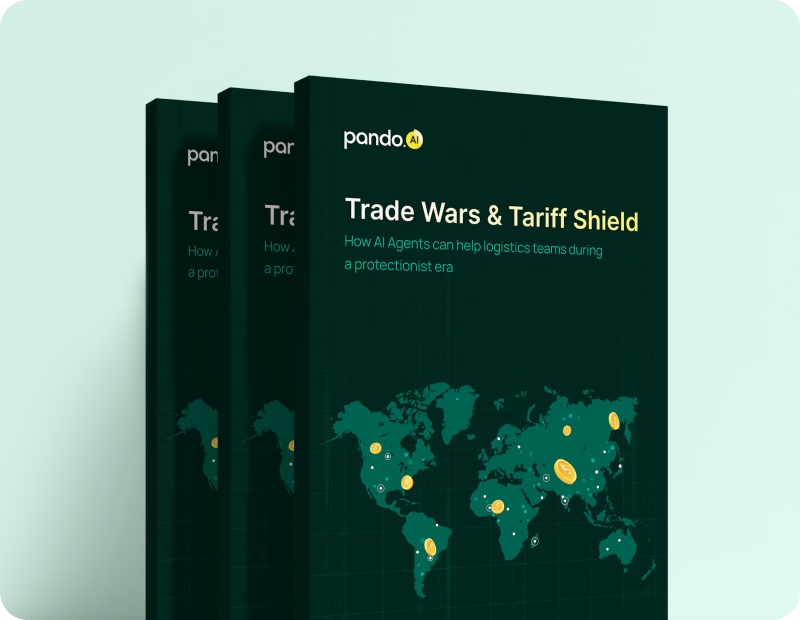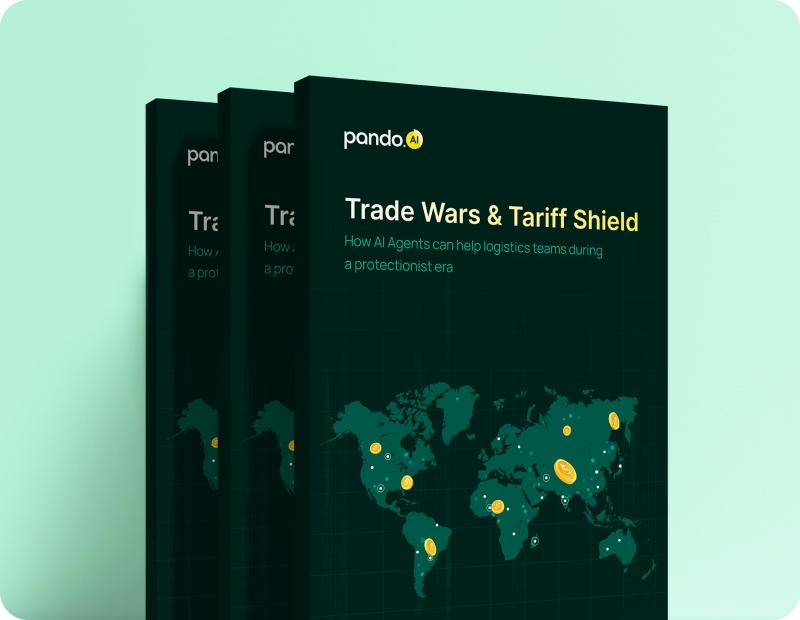-
Products Products
- Industry
- Initiatives
- Resources
- Company
- Book a demo

Before you go: Logistics leaders just dropped the truth on AI
The State of AI in Logistics 2025 is here — no hype, just real conversations and raw insights.
Build a collaborative multimodal freight partnership with a unified TMS — A complete guide
Your global logistics operations can scale when you prioritize a collaborative multimodal freight partnership. Read on to learn why it is essential.
Published on September 25, 2024 • 7 mins read
Rohit Lakshman

Your global logistics operations can scale when you prioritize a collaborative multimodal freight partnership. Read on to learn why it is essential.
You can’t manage what you can’t see. The hard part is that you lose track of the milestones of your shipments when you manage multimodal logistics. You struggle to manage warehouse, order, or inventory-level activities with a broken system. The growing inefficiencies, from load consolidation to planning across transportation modes and mode selection to tracking the shipment, make everything for multimodal freight management challenging.
A collaborative approach helps you tackle all these multimodal freight management challenges. Here’s where you need a unified TMS platform to help you build collaborative freight forwarding with multimodal logistics services, streamline freight management activities, and increase productivity and cost efficiency. The universal truth is a multimodal TMS is a powerhouse for driving logistics agility and building seamless partnerships with multimodal freight partners.
Multimodal logistics: Why is it the best transportation method for shippers?
It isn’t wrong to say that multimodal transportation for shipment is a customized solution. You can combine air, ocean, rail, and road transportation modes to ship orders to your customers. As a result, it brings tons of multimodal freight advantages such as:
- Cost-efficiency: By combining various transport modes, you can choose the most cost-effective routes to reduce fuel expenses and overall transportation costs. A report by Research and Market also claims that multimodal transport lowers transportation costs by 20%.
- Reduced transit time: Choosing a multimodal carrier allows you to use different modes of transportation, reducing transit times and enhancing delivery compared to a single mode of operation.
- Streamlined logistics: The benefits of multimodal transportation translate to superior user experience. You only work with a single point of contact to manage multiple modes, which is good for contract management and long-term relationships with multimodal shipping companies.
- Enhanced delivery services: Working with multimodal carriers ensures that delays can be easily mitigated by optimizing modes as and when a particular mode (road or rail) fails.
- Sustainable logistics: Rail freight emits fewer GHGs or CO2 per ton per kilometer than other modes. Sea freight is relatively eco-friendly; however, road freight has a high environmental impact, followed by air freight.
Our World in Data report claims that road freight alone contributed 30% of the seven billion tons of CO2 emissions in 2022. Water and air account for 10% and 11% of emissions, respectively, while rail contributed 1% of the total CO2 emissions.
Hence, one of the best advantages of multimodal transport providers is the ability to reduce carbon footprint by using rail or sea wherever possible and reducing the use of road and air modes of transport. This helps maintain sustainable logistics and save on fuel costs too.
The advantages of multimodal logistics can only be realized when you efficiently facilitate collaborative partnerships between logistics service providers across every touchpoint. Unfortunately, paper-based systems make freight management more challenging.
Challenges of multimodal freight management
For global logistics operations, when you need to manage all modes— road, rail, air, and ocean, it’s quite an overwhelming task. When done manually, errors are inevitable, which can impact the time of arrival and incur high costs. Below are some of the challenges of multimodal freight management.
Delays in freight procurement
Freight rate volatility is a perpetual headache amidst the uncertainty in the logistics market. Combining various paper-based records to compare rates based on service (less truck load, truck load, or parcel) and mode types is a complex task. The outcome is delayed mode selection and shipment delivery.
Poor visibility across multimodal logistics
The dilemma with broken systems is that you cannot get a single pane of view of your freight planning and execution for multimodal transportation. It is hard to compare different SKU variabilities and optimize appropriate mode use. Other than this, during the downstream logistics, the lack of visibility restricts real-time response to disruptions and impacts ETAs.
Chaotic document management
A paper-based document management is an error-prone approach. One mistake can stall progress in the entire value chain. Additionally, manually creating documents for every shipment event is frustrating and time-consuming, impacting SLA compliance with global trade regulatory bodies.
Inefficient carrier tendering
Back-and-forth carrier tendering processes make rewarding the proper contract to the suitable carrier challenging. Besides, collaborating with the right carrier partners is complicated due to the lack of market intelligence and access to performance metrics.
High operating costs
Manual freight procurement largely misses the benefits of advanced automation, which can increase the rate of errors and delays from transportation planning to execution. The outcome could be drastic. Improper capacity utilization forces you to use fleets meant to transport other goods or the lack of real-time collaboration between carriers can result in empty miles. Manual freight management thus hits your bottom line in several ways.
Solutions to overcome multimodal freight management challenges
A unified transportation management system enhances collaboration between freight forwarding partners, boosts collaborative shipment execution, and helps you tackle global shipment challenges. Here’s how you can manage your global shipment.
Ship with the suitable carrier modes
A TMS system unifies each piece of data for you on a single platform, using AI/ML capabilities to enhance data-driven decisions for optimal mode selection based on material capacity, transit time, transit risks, service types, and product attributes. In addition, an automated workflow helps you capture the right mode of freight for air, ocean, rail, or road through rate-shopping for a sudden market demand or specific orders.
Unlock freight visibility across the multimodal transportation
Powered by AI/ML technologies, a comprehensive TMS enhances visibility across transport planning and execution. The ability to optimally consolidate capacity based on carrier modes, routes, and customer types is one of the best advantages of multimodal transport that allows you to maximize space within trucks or containers. Also for downstream logistics, you can track and trace your shipment in real-time and achieve event-based milestones for multimodal transportation and gain predictive ETAs.
Manage document seamlessly
Digitized TMS solutions create a collaborative ecosystem for carrier partners, enabling them to monitor shipment progress at every event and streamline documentation digitally. With a configurable workflow, you can automate the creation of PoD, bill of lading, invoice assignment, and other shipping documents according to country rules and ensure SLA compliance
Leverage collaborative carrier tendering
Multimodal TMS platforms support collaborating with a network of freight forwarders. By harnessing analytics that help determine performance benchmarks and market rates, you can make data-driven decisions to tender a carrier effectively. Automated tender creation enables you to adapt to sudden market requirements with spot buys and even continue your relationship with the existing carriers.
Reduce overall operating costs
The unified TMS solution provides a collaborative platform where shippers and freight forwarders connect seamlessly, giving end-to-end visibility about each leg of transportation planning and execution activities. You can save a significant amount of money by optimally managing freight capacity, route planning, and backhaul planning with advanced data analytics.
Considerations for choosing a multimodal TMS platform
Building end-to-end visibility across your carrier partners helps every stakeholder get better control over shipment activities. A multimodal TMS platform is a game changer in facilitating this objective. If you want to embark on a multimodal TMS journey, consider the following factors.
- AI/ML powered TMS
Leverage AI/ML technologies to detect and adjust the most efficient routes for your shipment. Make sure you can gain the ability to track shipment milestones through predictive ETAs, detect shipment anomalies in transit, and optimize capacity through 3D loading.
- Dynamic rate forecasting
Freight rate volatility can be daunting when managed manually. Ensure you can leverage dynamic rate forecasting to tap into real-time market and historical rates. This can help you adjust to fluctuating rates and capture the best deal, even with a non-contracted freight forwarder or new carrier partners.
- Industry templates
Confirm that a multimodal logistics platform uses pre-configured and industry-specific templates in compliance with standard practices. At times, this can help you avoid the groundwork for customizations while increasing user adoption for faster time to market and driving tangible value.
- Seamless integration
Consider integrated visibility with the ability to combine multiple data points between various third-party systems through robust API-led configurations. Confirm seamless integrations with WMS, IoT devices, and client ERP to enable SKU-level optimization, payment reconciliation, and downstream logistics automation.
- Collaborative UX
Seek a frictionless user interface in a unified multimodal TMS, which promises seamless access to mobile apps for collaborative connection and fosters a single source of truth for carriers and freight forwarders for executing collaborative shipments.
- Compliant and transparent
Ensure you can access time-stamped and user-tracked data logs to get insights into shipment milestones. These essential features are must-haves to track lead times or gain visibility into the shipment to final delivery and payment.
So, Yay or Nay on a Multimodal TMS?
The benefits of working with multiple modal carriers keep you ahead of the competition. You can drive multimodal freight management efficiency seamlessly and conveniently, remove the hurdles of manual intricacies across logistics. In the age of virtual freight forwarding, total retailing, and B2B or B2C ecosystems, where competition is stiff and margins get narrow, multimodal logistics services help you diversify shipping operations and capture tangible value.
For total peace of mind with multimodal freight partners to drive efficiency, productivity, and profitability, leverage a multimodal TMS solution.
Pando brings a unified platform to help you implement intelligent transportation management and elevate customer experiences. Book a demo today.
Subscribe to Pando blog and Crossroads newsletter now!
Stay up to date with the latest logistics, transportation, and supply chain tips and news.
Subscribe Here!













